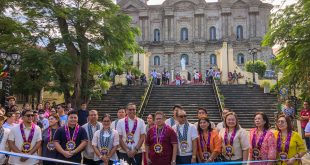Taal, is a 4th class municipality in the province of Batangas.
It is the Balisong and Barong Tagalog Capital of the Philippines.
Here is the History and Town Profile of Taal.
History
Taal’s present site is the third in a long and storied saga of prosperity, catastrophe and reconstruction.
Founded in 1572 by Spanish friars on the fertile bank of Pansipit River close to where the water emptied to Balayan Bay, Taal was devastated three years later by ferocious Moro pirates. The fledging town was then moved onwards to the shore at Taal Lake where it prospered and became eminent.
The fame suddenly ended. For in 1754 the deadly Taal Volcano erupted and reduced the town to wreckage. The Taaleños subsequently transferred the following year to safer and higher vicinity, not far away, on a lush inclined land where the town is now presently situated.
Once became the bustling capital of a province that grew to fame from 1732 to 1754, Taal was recognized as one of the most prosperous, progressive, and influential towns of the Philippines for more than two hundred years.
Town Profile:
Spoken Language:tagalong and english
Total Population: The 2007 population is 41,352 growing at 2.33% annually
Coordinates: 13° 53′ 39″ N, 120° 55′ 45″ E
Political Subdivisions: 42 Baranggays
Apacay
Balisong
Bihis
Bolbok
Buli
Butong
Carasuche
Cawit
Caysasay
Cubamba
Cultihan
Gahol
Halang
Iba
Ilog
Imamawo
Ipil
Luntal
Mahabang Lodlod
Niogan
Pansol
Poblacion 1
Poblacion 2
Poblacion 3
Poblacion 4
Poblacion 5
Poblacion 6
Poblacion 7
Poblacion 8
Poblacion 9
Poblacion 10
Poblacion 11
Poblacion 12
Poblacion 13
Poblacion 14
Pook
Seiran
Laguile
Latag
Tierra Alta
Tulo
Tatlong MariaClimate: dry from November to April, and wet during the rest of the year
Economy:Agricultural production
sources:Taal Grand Lady of Batangas , tourist brochure
Wikipedia.org
 WOWBatangas.com Your Source of Great News and Stories from the Province of Batangas, Philippines
WOWBatangas.com Your Source of Great News and Stories from the Province of Batangas, Philippines



